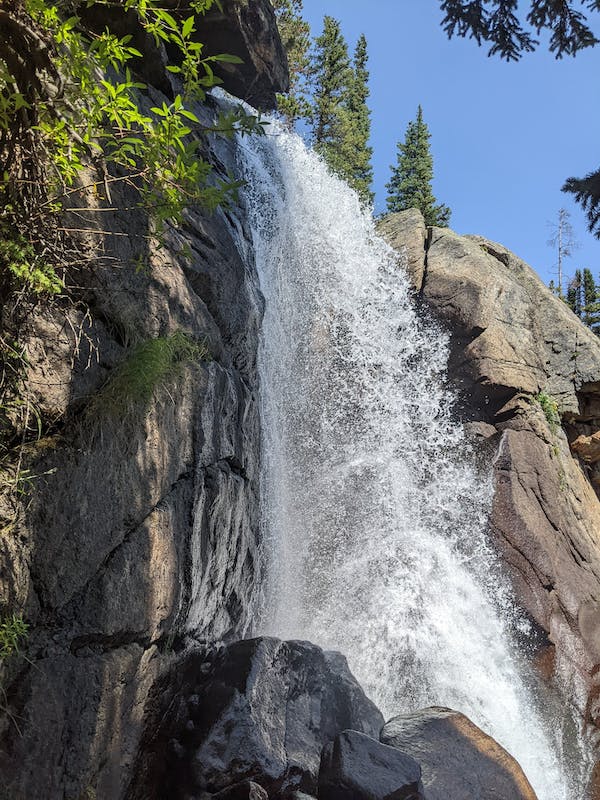Prepare your camera and indulge yourself with picture-perfect scenes from Rocky Mountain National park, one of the most photographed national parks in the US. It is about 76 mi (122 km) northwest of Denver International Airport in north-central Colorado, within the Rocky Mountains Front Range.
The park sits between the towns of Estes Park to the east and Grand Lake to the west. The Continental Divide’s eastern and western slopes run directly through the center of the park with the Colorado River’s headwaters located in the park’s northwestern region.
The park’s notable features include mountains, alpine lakes, and abundant wildlife within various climates and environments, from wooded forests to mountain tundra.
THE MOUNTAINS
There are more than 100 peaks within the boundaries of Rocky Mountain National Park. The mountains rise above 11, 000 feet altitude, including the 14, 259 feet Longs Peak. The taller peaks where snowmelt runs either west to the Pacific Ocean or east to the Atlantic, make up the Continental Divide. The beautiful and amazing mountains that cradle the Estes Valley provide residents and visitors with the unforgettable experience of nature’s beauty and inspiration. Travelers and explorers can access the park’s vistas through a horse, foot, or car. Trail Ridge Road is the most notable vehicle route with the highest continuously paved highway in North America.
These soaring peaks offer plenty of photographic opportunities for both the expert and novice photographer visiting the Rocky Mountain National Park.
WILDLIFE
The park’s varying topography creates a variety of habitat, making the entire place indeed home to many species of animals, which include almost 300 bird species and nearly 70 species of mammals. There can be 2000-3000 elk in summer, and between 800 and 1,000 of them spend the winter within the park’s boundaries.
Besides elk, other ungulates reside in the park, including bighorn sheep, moose, and mule deer. However, species like wolf packs, wolverine, grizzly bear, and some American bison have been extirpated from this park. There was the elimination of the Bison from the park during the 1800s, as were pronghorn and moose. Moose was restored to the area in 1978 and is now frequently seen in the park, especially on its west side.
HISTORY OF THE PARK
President Woodrow Wilson approved the Rocky Mountain to be a national park on January 26, 1915, and established the boundaries and protected future generations’ area. The primary vehicle route, Trail Ridge Road, was built by the Civilian Conservation Corps in the 1930s. The park received the UNESCO’s title to be the one of the World Biosphere Reserves in 1976. Many visitors came to the park that it became one of the most visited in the National Park System, ranking 3rd in 2015. Over 4.5 million visitors have entered the park in 2018 and still increasing in 2019.
There are five total visitor centers with park headquarters located at the Beaver Meadows Visitor Center—a National Historic Landmark designed by the Frank Lloyd Wright School of Architecture at Taliesin West.
INCREDIBLE ADVENTURES
Many activities and sports you can indulge in the summer/fall and winter/spring seasons in the Park. If you are exploring new routes to an adrenaline rush or simply enjoying a favorite pastime, Rocky Mountain National Park’s unique and varied landscapes offer something fun.
- Hiking
The park offers 355-mile hiking trails that range from flat lakeside strolls to steep mountain peak climbs. Mt.Ida, Flattop Mountain and Hallett Peak, Ypsilon Lake Trail, Chasm Lake, and Sky Pond are a few of the most favorite hikes. If you and your company are new to these trails, best to consult with rangers at visitor centers or the Wilderness Office to advise trails suitable to different fitness and experience levels.
- Wildlife Watching and Photography
Animals free from the walls or cages are still the best experience. The park’s large population of the wild animals makes it one of the top destinations for wildlife watching whether of elk, bighorn sheep, mule, deer. Etc. There are also a lot of birds, bees, and butterflies in the park.
- Scenic Drives
There is also a road system that gives visitors access to diverse ecosystems characterizing the higher regions of the central Rocky Mountains. The roads lead to lowland meadows and aspen groves along swift-flowing rivers and up through subalpine forests to more than 12,000 feet in elevation. Trail Ridge Road is one of the most famous scenic drives in Colorado. It has the highest point of 12 183, the highest continuously paved road in the United States.
- Camping
One of the perfect night view you can ever experience is under the night sky at the Rocky Mountain National Park! Five campgrounds offer fantastic opportunities for outdoor fun and adventure. You can have camping reservations, which is highly recommended since many visitors are also booking a camping slot.

